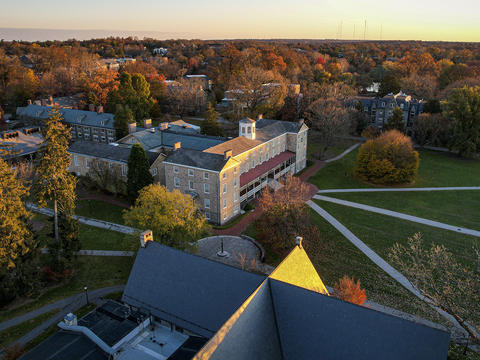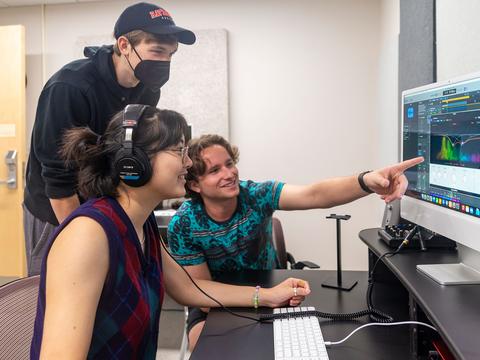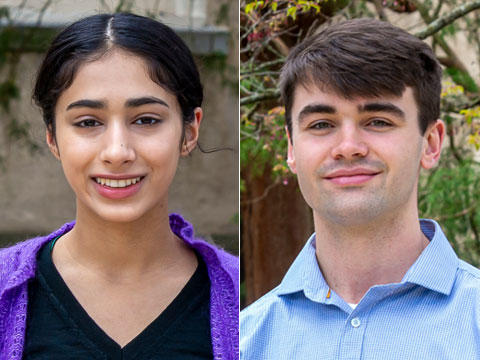Students Speak the Language of Science at National Conferences

Details
In 1998, over 20 Haverford students in fields as diverse as astronomy, biology, chemistry, psychology, physics and mathematics accompanied their professors to professional research conferences across the United States. For most of these students, the trips provided more than just a chance to peruse the research of others, but to present their own findings to scientists and academicians around the country.
And, despite their fears of getting silenced by a cacophony of theorems, equations, hypotheses and graphs, most discovered they were gaining their own distinctive voice in the language of science. It's a voice that most young scientists usually don't find until graduate school.
"It was such an exciting opportunity to talk to scientists and to realize I was doing real science," says biology major Donna Kaminski '98, who attended the annual meeting of the American Society for Cell Biology in Washington D.C. "I realized I was speaking the same language as a Ph.D. student."
Kaminski's advisor, assistant professor of biology Karl Johnson, explains such conferences ultimately provide students with one of their first opportunities to see the greater science community. And what they see is usually an eye-opener about their own development as scientists.
For students like Sam Floyd'99, Madison Compton '99 and Jessica Shapiro '99, reality hit the minute they found themselves standing alone in front of a bulletin board presenting "posters" to hundreds of scientists on the research they had done with their respective professors. Each was expected to field any and all questions sent their way from the hundreds of conference attendees who passed by their bulletin boards.
"The one big obstacle was to figure out who you were really talking to and what level of understanding they had of the topic," recalls Compton, a physics major who presented a poster at the March 1998 meeting of the American Physical Society in Los Angeles. The poster presented research he and physics faculty members Suzanne Amador and Lyle Roelofs had conducted to determine the structural properties of single layers of phospholipids.
Amador said their research generated several questions that Compton had to field solo. It was a fairly smooth introduction for Compton to the world of conferences. But, she notes, sometimes students can find themselves in a "sink or swim" situation.
At the Biophysical Society Annual Meeting in Kansas City in late February of 1998, biology and philosophy double major Sam Floyd presented a poster on research he had done with Amador on "Interaction of Local Anesthetics with Phospholipids in Languir Monolayers."
"There was a lot of interest and Sam really had to work hard," recalls Amador. "He was on his feet for two and a half hours and really had to talk." And she says some scientists weren't always appreciative about getting their information from an undergraduate.
But Floyd is enthusiastic and reflective about his experience: "Presenting a poster at a conference can be somewhat intimidating for an undergraduate, since scientists tend to be fairly competitive people," he explains. "There are always one or two who set out to disparage your work, or to assert themselves as more knowledgeable about your field. However, even at the undergraduate level, student-researchers know more about their own work than anyone else. It is possible to hold one's own in an exchange with accomplished scientists when discussing one's own work."
At the American Society for Cell Biology in Washington D.C. Jessica Shapiro, who had worked at the National Institutes of Health in Bethesda, Md. prior to attending Haverford, presented her poster on research she and Professor Johnson did on a molecular chaperone protein found in the single celled green algae, Chlamydomonas. Shapiro not only fielded questions at the conference, but got her first real exposure to another universal aspect of conferences: networking.
"I kept running into people I met at National Institutes of Health," Shapiro says.
At the Annual meeting of the Eastern Psychological Association in Boston psychology major Jessica Dunne '98 discovered that good research ultimately leads to more research. She says after Marilyn Boltz, professor of psychology, presented their soon-to-be published paper, the audience immediately asked questions. The paper was on the influence of learning on the human ability to accurately estimate the duration of certain events, and Dunne says the audience was very interested in how the research was applicable to their own lives - particularly in the office environment.
All of the students agree that the conferences helped them to better plan for their own careers by exposing them to the variety of research and the vital fields of study available to them.
"It showed me how fresh and on top of the literature you had to be and how much you have to bring into the lecture that's being presented," says Dunne who in the summer of 1998 worked a job at the NIH continuing research that she did there last summer as an intern: studying children and what influences their ability to give accurate eyewitness accounts of events.
"I was amazed by the magnitude of the science being done out there and the quickness," says Kaminski who in the summer of 1998 had a fellowship as a laboratory assistant at the NIH in an AIDS research lab. "If you go to a conference, you realize that science isn't just moving forward, it's leaping forward. You go to a conference and you realize the next question you had is already being answered."



